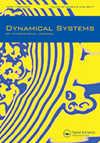甲型禽流感模型环境传播和外溢传播的数学模型和非标准有限差分格式分析
IF 0.6
4区 数学
Q4 MATHEMATICS, APPLIED
引用次数: 2
摘要
摘要本工作采用非线性常微分系统对环境和外溢传播对A型禽流感病毒(AIV)感染的影响进行建模、分析和评估,该系统考虑了五种传播途径:家禽到家禽;环境对家禽;禽传人(外溢事件);环境对人类,家禽对环境。对该模型进行了深入的理论和数值分析如下。基本繁殖数被计算出来,并被证明是子模型在没有招募受感染家禽的情况下的全局渐近动力学的一个尖锐阈值。这些结果是通过构造合适的李雅普诺夫函数以及Poincaré-Bendixson与李雅普诺拉萨尔技术相结合的应用而获得的。当受感染的家禽被带入种群时,该模型只表现出一个独特的地方病平衡,其全局渐近稳定性是使用前面提到的相同技术建立的。此外,该模型显示出跨临界分叉,其中基本再现数的值之一是分叉参数阈值。我们进一步证明,在禽流感爆发期间,招募受感染的家禽会增加疾病的流行水平。我们证明了经典的Runge-Kutta数值方法未能保持解的正性,并设计了一个非标准有限差分格式(NSFD),该格式保留了连续系统的基本性质。通过数值模拟来说明理论结果,并评估环境和溢出传播对疾病的作用。本文章由计算机程序翻译,如有差异,请以英文原文为准。
Mathematical modeling and nonstandard finite difference scheme analysis for the environmental and spillover transmissions of Avian Influenza A model
ABSTRACT This work models, analyzes and assesses the impacts of environmental and spillover transmissions on Avian Influenza Virus (AIV) type A infection formulated in terms of nonlinear ordinary differential system that takes into account five spreading pathways: poultry-to-poultry; environment-to-poultry; poultry-to-human (spillover event); environment-to-human and poultry-to-environment. An in-depth theoretical and numerical analysis of the model is performed as follows. The basic reproduction number is computed and shown to be a sharp threshold for the global asymptotic dynamics of the submodel without recruitment of infected poultry. These results are obtained through the construction of suitable Lyapunov functions and the application of Poincaré-Bendixson combined with Lyapunov-LaSalle techniques. When the infected poultry is brought into the population, the model exhibits only a unique endemic equilibrium whose global asymptotic stability is established using the same techniques mentioned earlier. Further, the model is shown to exhibit a transcritical bifurcation with the value one of the basic reproduction number being the bifurcation parameter threshold. We further prove that during avian influenza outbreaks, the recruitment of infected poultry increases the disease endemic level. We show that the classical Runge-Kutta numerical method fails to preserve the positivity of solutions and alternatively design a nonstandard finite difference scheme (NSFD), which preserves the essential properties of the continuous system. Numerical simulations are implemented to illustrate the theoretical results and assess the role of the environmental and spillover transmissions on the disease.
求助全文
通过发布文献求助,成功后即可免费获取论文全文。
去求助
来源期刊
CiteScore
0.90
自引率
0.00%
发文量
33
审稿时长
>12 weeks
期刊介绍:
Dynamical Systems: An International Journal is a world-leading journal acting as a forum for communication across all branches of modern dynamical systems, and especially as a platform to facilitate interaction between theory and applications. This journal publishes high quality research articles in the theory and applications of dynamical systems, especially (but not exclusively) nonlinear systems. Advances in the following topics are addressed by the journal:
•Differential equations
•Bifurcation theory
•Hamiltonian and Lagrangian dynamics
•Hyperbolic dynamics
•Ergodic theory
•Topological and smooth dynamics
•Random dynamical systems
•Applications in technology, engineering and natural and life sciences

 求助内容:
求助内容: 应助结果提醒方式:
应助结果提醒方式:


